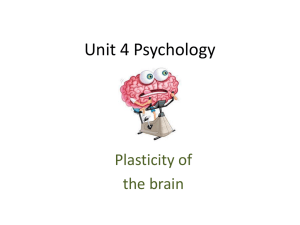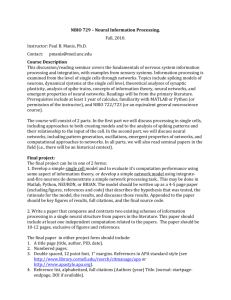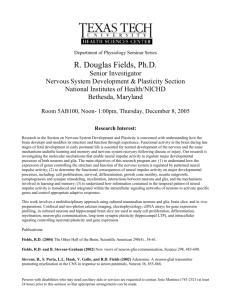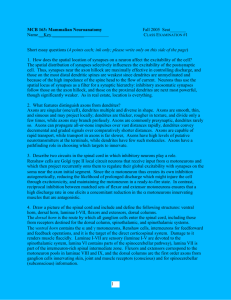Embryonic and Neural Development
advertisement
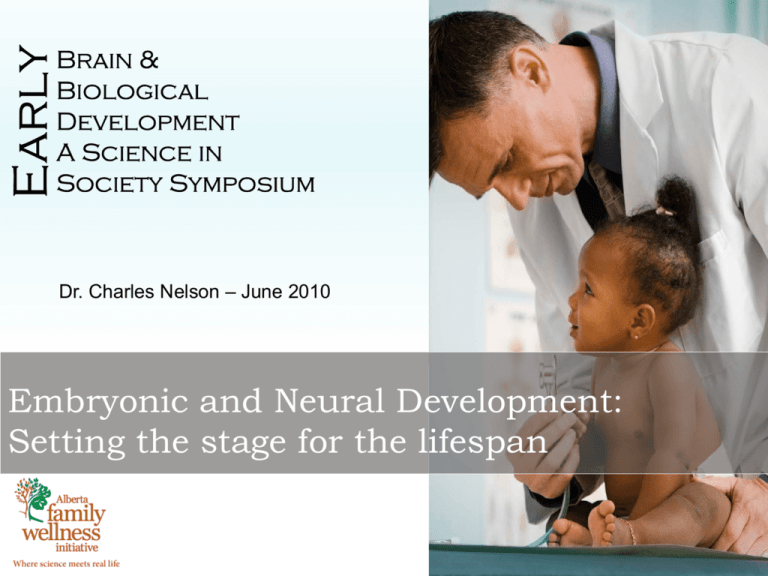
Dr. Charles Nelson – June 2010 Embryonic and Neural Development: Setting the stage for the lifespan Outline I. Prenatal development II. A tutorial on brain development III. Précis to Neural Plasticity Developmental Milestones Across the Life Span • • • • • • • • • • At At At At At At At At At At age 4 success is . . . not peeing in your pants. age 12 success is . . . having friends. age 16 success is . . . having a driver s license. age 20 success is . . . having sex. age 35 success is . . . having money. age 50 success is . . . having money. age 60 success is . . . having sex. age 70 success is . . . having a driver s license age 75 success is . . . having friends. age 80 success is . . . not peeing in your pants. Prenatal Development + • Sperm + Egg = one cell containing 46 chromosomes (23 pairs); called ZYGOTE. • GERMINAL STAGE – Cells multiply (cleavage) 12-16 cell stage called MORULA. – By 4th day after conception, mourula has 16 to 64 cells. Each cell beginning to change shape and position, and now called BLASTOCYST. • • • Dividing cells begin to pull away from center of mass and a cavity forms. Inner layer will form embryo (then infant), and outer layer forms support structures (placenta, amniotic sac, umbilical cord). 7-8 days after conception, blastocyst implants in uterus. NOTE: where implantation takes place one of determinants of pregnancy outcome, e.g., blood supply in various parts of uterus may be inadequate to support organism development, or may result in undernourished newborn. Image from Dworetzky, J. P. (1996). Introduction to Child Development (6th ed.). St. Paul, MN: West Publishing Company. Embryonic Stage • Embryo forms 3 layers of cells: • Inner layer of germ cells is precursor to the ENDODERMAL cells that eventually form lining of internal organs, such as digestive tract, respiratory system, bladder, etc. • Outer layer of germ cells gives rise to 2 additional kinds of cells: – ECTODERMAL cells (outer), which develop in 2nd week post conception, and which become skin, sense receptors, nerve cells (and brain generally) mammary and pituitary glands, etc. – MESODERMAL cells (middle), which develop in 3rd week, and which become the muscles (including heart), connective tissue (bone and cartilage), circulatory system, and most of excretory and reproductive systems. Some landmarks of embryonic development – 3rd week: neural tube (nervous system) develops (more elaboration shortly). – 21 days: eyes form 24 days: heart (although just a tube) begins to flutter and beat. (By this time about 5mm long) eye heart – 4th week: arm and leg buds appear, as does urogenital system. Heart develops into 4 chambers; blood vessels and cells begin to form – (NOTE: FROM THIS POINT ON EMBRYO HAS OWN CIRCULATORY SYSTEM THAT IS SEPARATE FROM MOTHER'S). • 5th week: cells inside arm and leg differentiate to become muscle cells, cartilage cells, and bone cells • 6th week: arms and legs more differentiated and face begins to form (but is not recognizable); liver, gallbladder, and pancreas begin to form • 7th week: facial structures fuse; errors here result in things like cleft nose, chin, and palate (which affect 1 in 500 births) • By 8 weeks, embryo weighs 1/30 oz and is about 1 in long. • During embryonic stage, 95% of body parts and structures form – process referred to as ORGANOGENESIS. • Because so much forming, also thought of as critical period, and organogenesis most vulnerable to disruption. Fetal Stage • What demarcates fetal from embryonic is that real bone cells begin to replace cartilage. Fetal period lasts 7 months and main event is substantial increase in size, along with elaboration and growth of body structures laid down during embryonic phase. • 3rd month: About 3". Can make breathing and sucking movements (no lungs, though). Can kick, make fist, turn head; fingers and toes formed, fingernails and toenails growing. • First reflexes appear (including facial reflexes, like squinting, frowning). Finally, sexual differentiation occurs. • 4th month: By 4th month fetus grows more than any other time (6", 6oz). Head 1/3 length (previously 1/2). It is now mother feels "quickening" (little flickers). Thumb sucking prevalent now; believed that this experience facilitates sucking reflex when born. • 5th month: Fetus 12", 16oz. Has sleep/wake cycles, and has favorite sleep position. But, still poor breathing mechanism. • 6th month: 14", 2 lbs. Eyelids finally open; skin red and wrinkled. Many taste buds on tongue and in mouth; good grasp reflex and some breathing movements; can perhaps do some crying. Is possible, but difficult, to keep such babies alive outside womb. Hand-to-mouth activity • 7th month: Growth slows down. Rough 23.5 to 25 weeks, fetus now considered VIABLE but needs protective environment. • 8th and 9th month: Red, wrinkled skin fills out with fat (provides insulation). Gains 1/2 lb. per week. Startle reflex is present; responds to light and sound, lifts its head. 60 percent of adult head size present Summary of Prenatal Development • Zygote forms after conception • Blastocyst embeds in uterine wall • Germinal stage gives rise to embryonic stage, which lasts about 8 weeks; during this time all organs, systems, etc. form • Fetal stage lasts 7 months (in full term pregnancy) and is period of elaboration and growth • Labor and delivery culmination of all this hard work – generally,40 weeks post conception Part II. Introduction to Brain Development An Accelerated View of Brain Development 15 1/2 wks 27 weeks 22 weeks 23 weeks Full term brain http://medstat.med.utah.edu ~25 weeks Adult Neuralation • Days 18-24: – Dorsal (rear) region of ectoderm thickens and forms neural plate – neural plate forms a groove – neural tube forms – tube closes at rostral (top), then caudal (bottom) ends – cells trapped inside tube form Central Nervous System (CNS), those outside tube form Autonomic Nervous System (ANS) Neural Tube Formation Source: From !The Induction and Patterning of the Nervous System," by T. M. Jessell and J. R. Sanes, 2000, in E. R. Kandel, J. H. Schwartz, and T.M. Jessell (Eds.), Principles of neuroscience (4th ed., p. 1020, fig. 52-1), New York: McGraw Hill. Source: From !The Induction and Patterning of the Nervous System,"by T. M. Jessell and J. R. Sanes, 2000, in E. R. Kandel, J. H. Schwartz, and T.M. Jessell (Eds.), Principles of neuroscience (4th ed., p. 1020, fig. 52-2), New York: McGraw Hill. Neurogenesis • Precursors to neurons and supportive tissue (glia) form; this continues postnatally. • Was previously believed most neurogenesis was complete at birth. • We now know that there is postnatal neurogenesis in at least one area (hippocampus; involved in memory) through at least middle age • Influenced by experience (learning, exercise↑new neurons, and negative/stress ↓ new neurons, notably in hippocampus). • Mystery: what is the purpose of these cells? Cell Migration • Following neural tube closure, there is proliferation of a single layer of epithelial cells that line the tube. • Cells are connected to each other and in some cases, to radial glial fibers. • Expansion occurs between layers • Neuroblasts climb onto fibers and migrate radially or tangentially (see next slide). Source: www.rockefeller.edu/pubinfo/astrotactin.nr.html (photo: Mary E. Hatten, Ph.D.) Cell migration in ferret Courtesy of Susan McConnell, Ph.D Cell Migration • The cerebral cortex forms in insideout pattern. 4 5 6 Time Differentiation and Synaptogenesis • Differentiation refers to – growth of axons and dendrites – formation of synapses and – synthesis of neurotransmitters. • Some dendrites and axons form as early as the 15th week; big increase seen after 25th week • Both axons and dendrites continue to develop into second postnatal year; thus, is an initial overproduction of axons and dendrites followed by retraction • Not all cells differentiate; there is massive programmed cell death (apoptosis), during which 40 - 60% of cells die. Source: http://technology.open.ac.uk/emsuite/img23.html Synaptogenesis • As with axons and dendrites, is an initial overproduction of synapses, such that newborn brain has many more synapses than adult brain. • First synapses observed about 23rd prenatal week, with rapid proliferation that follows and continues postnatally (keep in mind that synapses can t form until axons and dendrites have been born). • This is followed by retraction to adult levels. • In human, rate of retraction varies from brain area to brain area. Retraction of Synapses • In visual and auditory cortices, adult levels of synapses are obtained in early childhood (2 - 6 years). • In the middle frontal gyrus, adult levels are not reached until mid- to late adolescence (see next slide). From Huttenlocher (1979) Summary of Synaptogenesis • Synapse overproduction occurs early in life, whereas synapses elimination occurs much later, and varies greatly by area. – e.g., 6 years for visual cortex, 15+ years for prefrontal cortex Myelination • Myelin is lipid/protein substance produced by glia • Myelin wraps itself around axon as form of insulation. • Myelin speeds conduction velocity • Myelination has implications for both serial and parallel processing (e.g., multitasking). Myelination • Myelination occurs in ! waves"beginning prenatally and ending in young adulthood (and in some regions, as !late"as middle age). • Historically, researchers stained for myelin in postmortem tissue. • We now use – Magnetic Resonance Imaging (MRI) (see next slides) to distinguish white (i.e., myelinated) from gray (unmyelinated; generally cell bodies) matter – Diffusion Tensor/Diffusion Weighted Imaging (DTI) to identify myelinated fiber and fiber tracts (see next slides) The Challenge of Gray/White Matter Segmentation in Neonates a Neonate c Adult Fiber Tracking Genu and Splenium of Corpus Callosum Internal Capsule/ Auditory Tract Part III: Neural Plasticity • Does the structure of experience work its way into the structure of the brain, and if so, how? Role of Experience (Con t) • The impact of experience on the brain is not constant throughout life • Early experience often exerts a particularly strong influence in shaping the functional properties of the immature brain. • Many neural connections pass through a period during development when the capacity for experience-driven modification is greater than it is in adulthood. Such phases are referred to as sensitive or critical periods. • Language skills, emotional responses, and social behavior, as well as basic sensory and motor capacities, are shaped powerfully and permanently by such early experience. Typical Trajectory – a few ! speed bumps"but basically development stays on course Courtesy of William Greenough, modified by Eric Knudsen, !borrowed"by Charles A. Nelson III Effects of early (blue ball) vs. late (green ball) !negative"experience on brain development, both leading to atypical final outcome Courtesy of William Greenough, modified by Eric Knudsen, !borrowed"by Charles A. Nelson III General Conclusions about Plasticity • Dr. Kolb will talk at great length about plasticity. For now, assume – The likelihood of a given behavioral system exhibiting plasticity seems to depend on whether the system being challenged is one … • that has had the right early experience to ! set"it (e.g., access to a normal visual world) • In which function is somehow essential to the infant early in life • If so, will likely exhibit a sensitive period and will be less plastic with time; • if not, then no sensitive period and more plastic with time General Conclusions about Plasticity • that depends on neural circuits whose elaboration require exposure to particular types of experience during a sensitive period of time, and finally • that requires continual challenges and/or maintenance thereafter. Overall Conclusions • The formation of the brain commences within weeks of the formation of the embryo • Although the basic architecture of the brain is laid down by the third trimester of pregnancy, brain development continues through the first 2-3 years of postnatal life, when the brain looks (but doesn t function like) the adult brain Overall Conclusions (con t) • But, in key regions (e.g., prefrontal cortex) and in key ways (e.g., myelination), brain development continues in earnest through adolescence/young adulthood. • This prolonged process of development brings with it both a period of opportunity or vulnerability – what we refer to as !neural plasticity" • We ll learn more about plasticity from Dr. Kolb. THE END


